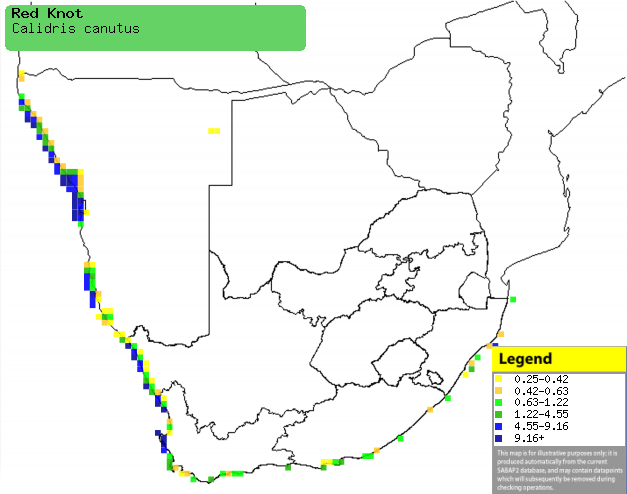|
Calidris canutus (Red knot,
Common knot)
Knoet [Afrikaans]; IJslandse kanoetstrandloper [Dutch];
Bécasseau maubèche [French]; Knutt [German]; Seixoeira [Portuguese]
Life
> Eukaryotes >
Opisthokonta
> Metazoa (animals) >
Bilateria >
Deuterostomia > Chordata >
Craniata > Vertebrata (vertebrates) > Gnathostomata (jawed
vertebrates) > Teleostomi (teleost fish) > Osteichthyes (bony fish) > Class:
Sarcopterygii (lobe-finned
fish) > Stegocephalia (terrestrial
vertebrates) > Tetrapoda
(four-legged vertebrates) > Reptiliomorpha > Amniota >
Reptilia (reptiles) >
Romeriida > Diapsida > Archosauromorpha > Archosauria >
Dinosauria
(dinosaurs) > Saurischia > Theropoda (bipedal predatory dinosaurs) >
Coelurosauria > Maniraptora > Aves
(birds) >
Order: Charadriiformes > Family: Scolopacidae
 |
|
|
Red knot, West Coast National Park, South Africa. [photo
Trevor Hardaker ©] |
|
Distribution and habitat
Breeds in the Arctic tundra mainly above 70° North, heading
south in the non-breeding season to Europe, South-East Asia, Australasia,
Central and South America and Africa's west coast from Mauritania through West
Africa to southern Africa. Here it is locally fairly common along the west coast
from Namibia to the Cape Peninsula, Western Cape, while more scarce further east
in the Eastern Cape and KwaZulu-Natal. It generally prefers large mud and sand
flats in sheltered coastal lagoon and embayments, occurring less regularly in
coastal wetlands, estuaries and open coasts.
|
 |
|
Distribution of Red knot in southern Africa,
based on statistical smoothing of the records from first SA Bird Atlas
Project (©
Animal Demography unit, University of
Cape Town; smoothing by Birgit Erni and Francesca Little). Colours range
from dark blue (most common) through to yellow (least common).
See here for the latest distribution
from the SABAP2. |
Predators and parasites
- Predators
- Parasites
- Cylocoelum mutabile (lung trematode)
Movements and migrations
Departs from its breeding grounds in July to
head down the east Atlantic seaboard and eventually reaching
southern Africa from September-October, leaving again in mid April.
It is capable of flying non stop for over 4000 km's, although some
birds may be incapable of making the journey back to the
breeding grounds and so stay in southern Africa through winter. The
proportion of juveniles in the region is linked to the abundance of
lemmings (Dicrostonyx torquatus and Lemmus sibiricus)
at its breeding colonies, as they are the main prey of Arctic foxes
(Alopex lagopus). About every third year lemmings are much
more scarce, so the foxes resort to feeding on the chicks of
ground-nesting birds, including the Red knot. This means that that
juveniles represent 24-61% of all the Red knots at Langebaan Lagoon
in normal years, but when lemmings are scarce the proportion of
juveniles is just 0-7%.
Food
It mainly eats bivalves, especially Tellimaya trigona, supplemented with other molluscs
(including the snail Hydrobia), polychaetes, crustaceans and echnoderms,
doing most of its foraging by pecking the ground or probing the mud while moving
forwards. It often joins mixed species flocks along with other waders, such as
Curlew sandpipers and
Little stints.
Threats
Not threatened, although global climate change is predicted
to result in the loss of 15% of its breeding habitat.
References
-
Hockey PAR, Dean WRJ and Ryan PG 2005. Roberts
- Birds of southern Africa, VIIth ed. The Trustees of the John Voelcker
Bird Book Fund, Cape Town.
|
